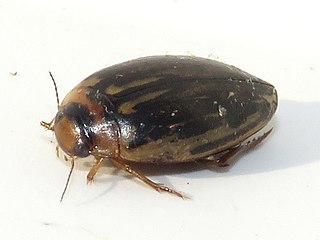
The Dytiscidae – based on the Greek dytikos (δυτικός), "able to dive" – are the predaceous diving beetles, a family of water beetles. They occur in virtually any freshwater habitat around the world, but a few species live among leaf litter. The adults of most are between 1 and 2.5 cm (0.4–1.0 in) long, though much variation is seen between species. The European Dytiscus latissimus and Brazilian Megadytes ducalis are the largest, reaching up to 4.5 cm (1.8 in) and 4.75 cm (1.9 in) respectively. In contrast, the smallest is likely the Australian Limbodessus atypicali of subterranean waters, which only is about 0.9 mm (0.035 in) long. Most are dark brown, blackish, or dark olive in color with golden highlights in some subfamilies. The larvae are commonly known as water tigers due to their voracious appetite. They have short, but sharp mandibles and immediately upon biting, they deliver digestive enzymes into prey to suck their liquefied remains. The family includes more than 4,000 described species in numerous genera.
Hydroporus compunctus is a species of predaceous diving beetle in the family Dytiscidae. It is endemic to the Canary Islands.
Hydroporus pilosus is a species of predaceous diving beetle in the family Dytiscidae. It is endemic to the Canary Islands.

Hoperius is a genus of predaceous diving beetles in the family Dytiscidae. This genus has a single species, Hoperius planatus. It is found in the United States east of the Rocky Mountains.

Coptotomus is a genus of predaceous diving beetles in the family Dytiscidae, the only genus of the subfamily Coptotominae. There are about six described species in Coptotomus, found in North America and the Neotropics.
Austrodytes is a genus of beetles in the family Dytiscidae found only in northern Australia. It was first described in 1978 by Chris Watts. The genus contains these two species:
Regimbartina is a genus of predaceous diving beetles in the family Dytiscidae. This genus has a single species, Regimbartina pruinosa.

Huxelhydrus is a genus of predaceous diving beetles in the family Dytiscidae. This genus has a single species, Huxelhydrus syntheticus, found in New Zealand.
Microdessus is a genus of predaceous diving beetles in the family Dytiscidae. This genus has a single species, Microdessus atomarius, found in Brazil.
Sinodytes is a genus of predaceous diving beetles in the family Dytiscidae. This genus has a single species, Sinodytes hubbardi, found in southern Asia.
Andex is a genus of predaceous diving beetles in the family Dytiscidae. This genus has a single species, Andex insignis.
Darwinhydrus is a genus of predaceous diving beetles in the family Dytiscidae. This genus has a single species, Darwinhydrus solidus, found in South Africa.
Dimitshydrus is a genus of predaceous diving beetles in the family Dytiscidae. This genus has a single species, Dimitshydrus typhlops. It is found in southern Asia.
Japanolaccophilus is a genus of predaceous diving beetles in the family Dytiscidae. There are at least two described species in Japanolaccophilus, one alive today and the other extinct.
Madaglymbus apicalis is a species of diving beetle. It is part of the genus Madaglymbus in the subfamily Copelatinae of the family Dytiscidae. It was described by Fairmaire in 1898. Madaglymbus apicalis is distributed along the coastlines of much of Africa.
Exocelina subjecta is a species of diving beetle in the genus Exocelina of the subfamily Copelatinae in the family Dytiscidae, described by David Sharp in 1882.
Exocelina cheesmanae is a species of diving beetle. It is part of the genus Exocelina in the subfamily Copelatinae of the family Dytiscidae. It was described by J. Balfour-Browne in 1939.

Copelatini is a tribe of diving beetles in the family Dytiscidae. It is the sole tribe in the subfamily Copelatinae. The largest genus within the tribe is Copelatus, which has about 470 described species found worldwide, but most diverse in tropical South America, Africa and South-East Asia.
Acilius sylvanus is a species of predaceous diving beetle in the family Dytiscidae. It is found in North America.
Acilius abbreviatus is a species of predaceous diving beetle in the family Dytiscidae. It is found in North America.




